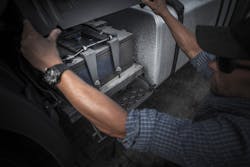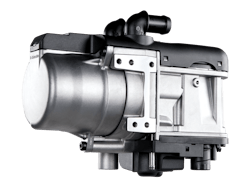It’s that time of the year again, when truckers must prepare for an onslaught of inclement weather from icy roads to freezing temperatures by winterizing their rigs. Preparation for the winter will be even more paramount this season for much of the country, as it looks like last year’s mild winter was a fluke.
Last winter, save for a few pockets in the Southwest and Pacific Northwest, the continental U.S. recorded above-normal temperatures, according to the National Oceanic and Atmospheric Administration’s Climate Prediction Center. This year, NOAA projects a more typical winter for most of the U.S., with a decent chance for colder temperatures spanning the Dakotas to Washington and higher than 50% probability for warmer weather from Arizona to Florida.
The Farmer’s Almanac concurred: “Our long-range forecast is calling for a cold winter with normal to below-normal temperatures in areas from the Great Lakes and Midwest, westward through the Northern and Central Plains, and Rockies” with “some very intense cold snaps and snowfall.”
That means top to bottom, inside and out, rigs should be ready for whatever is hurled at them, because even for areas that don’t see severe snow or freezing temperatures, the winter months hit truck equipment hard. The goal of maximum uptime and optimal safety can still be achieved by giving certain systems and components a little more love.
Battery and electrical system
“Winter is a very rough time of the year for vehicles,” said Larry Rambeaux, sales application engineer at electrical equipment supplier at Purkeys. He advised that truckers should start readying their tractors in the fall, with a focus on battery testing.
“Hot weather is what actually ruins the battery; cold weather is what makes it show up,” he said.
And drivers might not realize how the heat has impacted battery performance until an early cold snap starts, and the engine does not receive enough juice from the battery to get running.
“On a nice warm day, it's very easy to crank,” explained Rambeaux. “Once it gets cold, suddenly it gets a lot harder to crank that engine.”
According to Jeff Steer, national sales manager at starter manufacturer Vanair, batteries perform at 50% efficiency around 0 to 10 degrees F. “If the batteries were fatigued during the summer, now you are compounding that inefficiency, and the battery only has so much potential power,” he said.
Running a load test will ensure the dog days of summer didn’t take the bite out of the battery. Rambeaux also pointed out that incorrect spec’ing of the battery or having an inferior one perhaps put in during a roadside repair also could negatively impact a startup.
Visually inspecting all the associated cables and connectors is also crucial.
“That's worth a lot,” said Rambeaux, before adding, “There's nothing that replaces actually doing voltage drop tests on those cables.”
Even with a brand-new battery, corroded or loose wires impede the necessary juice from flowing to the motor.
“Every volt you lose between the battery and starter, you lose cranking speed,” he said. “The more voltage drop, the more loss of cranking speed, and you're never going to be able to spin that engine fast enough to start.”
Technology & Maintenance Council Recommended Practice RP 129A (TMC RP-129A: Heavy-Duty Vehicle Cranking and Charging Troubleshooting) provides the technical procedures for testing cranking and charging systems, though that is best performed by trained maintenance technicians with the right testing equipment.
“An hour of labor spent at a dealership is a lot cheaper than having to buy four batteries on the road,” Rambeaux offered.
Drivers should have an overall understanding of their system, especially when running an auxiliary power unit (APU). He said these systems will power cab amenities such as the microwave or television, as well as connect to the engine to keep it warm and reduce cranking requirements, but “it's not a nuclear power plant” and may be overworked if the microwave and several other appliances are drawing energy from it.
Engine
Getting the engine started on a freezing morning before heading out on the road is a major battle won, but an owner-operator must make sure it’s not part of a war of attrition.
Idling the engine up to the proper temperature up to around 180 degrees F can cause plenty of wear and tear. The American Trucking Associations equates an hour of idling every day to 64,000 miles of engine wear annually. Idling also consumes nearly a gallon of diesel per hour.
The alternative is getting a coolant heater that uses a fraction of the fuel, such as Webasto’s Thermo Top Evo, a SmartWay-verified idling reduction technology. The compact device circulates antifreeze around the cylinders to heat the engine block and can be programmed to automatically activate via the SmarTemp Control fx 2.0 app.
In one deployment with a leasing fleet of 230 trucks in central Pennsylvania, where the temperature was hitting 10 to 15 degrees F that winter, non-start/cold-start issues were cut by 95% by using an earlier model, the Thermo Top C, according to Webasto.
A preheated engine will have a less viscous oil lubricating the gaskets and injectors, thus easing the work a battery must expend to start the engine.
Coolant heaters have the added benefit of reducing particulates, soot and carbon sent to the exhaust system by 66% at 40 degrees F, said Don Kanneth, Webasto director for aftermarket heating, North America. This was validated by third-party testing.
Even in milder climates, coolant heaters can yield positive effects on the diesel particulate filter.
“By reducing the amount of carbon that's put in there, because your engine is now warm when you started instead of ice cold, you reduce particulate matter, which reduces the frequency of the need for regeneration cycles and filter changes,” Kanneth said.
For more savings, long-haul truckers can implement Webasto’s STC Air Top 2000 STC bunk heater, which uses one gallon of diesel per 22 hours, compared to nearly 18 gallons by idling over the same interval.
“The payback is tremendous because it’s about an 11 to 15-week ROI, at $3/gallon,” Kanneth said. They last for up to a decade and can be transferred to a new truck.
According to Webasto, about two out of every three sleeper cabs does utilize a bunk heater.
Fuel
Fuel issues can arise even before the full fury of winter arrives, as that’s when suppliers may switch to the winter blend. Ultra-low sulfur diesel and biodiesel contain waxes that can crystallize when cooled to gel the fuel or form into fluffy balls that rest at the bottom of the tank. These end up being sucked into the fuel pump and gunk up the works.
“We've heard stories of trucks having injector failures in the fall,” said Steve Muth, lead chemist at Penray. “What usually happens is the injector actually sailed in the summer, but the problem didn't show up until people redid the biodiesel content of the fuel because winter's coming and the injector started sticking.”
Another issue is water in the fuel that can freeze and block the fuel pump inlet or lines. Penray offers a Nox-Ice gas line antifreeze to carry out the water and dry the system, while diesel anti-gel additives break up the waxy buildup and protect the injectors and gaskets.
“If a $10 bottle of additive could prevent a $1,000 repair, you can think of the $990 difference as your return on investment, and this doesn't even consider the cost of downtime,” Muth said.
Penray also recommended to change the fuel filter prior to winter and have a bottle of Winter Thaw Emergency Diesel Fuel treatment onboard to thaw gelled fuel through a combination of isopropanol and a water dispersant.
Diesel algae, actually microbes that feed on diesel fuel and grow in the presence of moisture, are another problem to plan for.
“It only takes a small amount of water to wake them up and get them growing and reproducing," Muth said. “Run cleaner through the system, reduce water in the system, and just keep everything spotless, and there won't be any place for the bugs to grow.”
Having a ph test strip kit at the ready can confirm if a tank is infested.
Daily preventive maintenance can keep that from ever happening.
“It’s really critical that drivers drain their fuel tanks and their water filters every single day,” said Brent Bergevin, vice president of transportation for Gemini Motor Transport, a subsidiary of Love’s Travel Stops and Country Stores. “That’s going to be the number one problem that crops up and bites you.”
About the Author
John Hitch
Editor
John Hitch is the editor-in-chief of Fleet Maintenance, providing maintenance management and technicians with the the latest information on the tools and strategies to keep their fleets' commercial vehicles moving. He is based out of Cleveland, Ohio, and was previously senior editor for FleetOwner. He previously wrote about manufacturing and advanced technology for IndustryWeek and New Equipment Digest.



